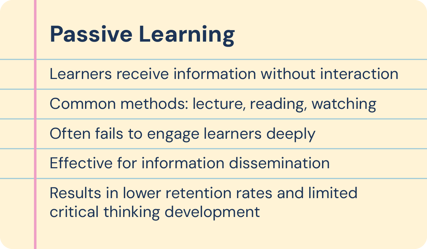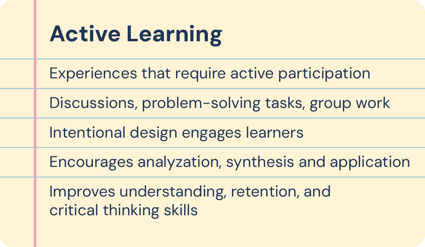What is Passive Learning?
The passive learning definition can be summarized as a method where students listen, observe, or read without significant involvement in the learning process.Passive learners typically absorb information without engaging critically or interactively, leading to limited retention and understanding.
The Difference Between Active and Passive Learning
Passive learning is a traditional approach where learners receive information without engagement or interaction. Typical passive learning activities include lectures, reading assignments, and watching videos. While these methods can be effective for information dissemination, they often fail to engage learners deeply, leading to lower retention rates and limited critical thinking development.Active learning, on the other hand, involves engaging learners through experiences that require active participation. This approach encourages learners to analyze, synthesize, and apply knowledge rather than merely absorb it. Techniques include discussions, problem-solving tasks, group work, and hands-on activities. Active learning has been shown to improve understanding, retention, and critical thinking skills.
The distinction between active learning vs passive learning is crucial for educators aiming to enhance student outcomes. As highlighted in the Active Learning Impact Study, students who engage in active learning tend to perform better academically, as they are more likely to retain information and apply it effectively. This study found that active learners saw a 13x increase in learner talk time, 16x more nonverbal engagement, and test scores 54% higher when compared to passive learners in a traditional lecture setting.


Video Conferencing Was Not Designed for Active Learning
Virtual web conferencing platforms have become integral to education and corporate training. However, these platforms often lead to passive learning experiences due to their design and typical usage:- Lecture-Style Delivery: Many virtual sessions mimic traditional lectures where the instructor talks, and learners listen. This one-way communication limits interaction and engagement.
- Lack of Physical Presence: The physical separation between instructors and learners can create a sense of detachment, reducing the immediacy and engagement that in-person interactions offer.
- Distraction and Multitasking: Learners are often in environments with numerous distractions. The temptation to multitask during virtual sessions can diminish their focus and engagement.
- Limited Interactive Features: Although platforms offer interactive features like polls, chat, and breakout rooms, they are often underutilized or not effectively integrated into the learning process.
Applying Evidence-Based Active Learning Practices in Virtual Classrooms
Active learning theories emphasize the importance of engagement and interaction in the learning process. Here are ways these theories can be applied in virtual classrooms:Constructivist Theory
Constructivist theory posits that learners construct knowledge through experiences and reflections. In virtual classrooms, this can be achieved through interactive activities like simulations, role-playing, and collaborative projects.
Cognitive Load Theory
Cognitive load theory highlights the importance of managing the amount of information presented to learners. Breaking content into smaller chunks and incorporating learning activities that help learners apply and process smaller chunks of content can help manage cognitive load and enhance learning.
Social Learning Theory
Social learning theory emphasizes learning through observation and interaction with others. Virtual platforms can facilitate social learning through discussion forums, group work, and peer feedback.
Read More: Leveraging Active Learning to Strengthen Business Outcomes
5 Tips for Educators and Instructors
To transform virtual classrooms from passive to active learning environments, educators and facilitators can implement the following strategies:1. Leverage Interactive Tools:
Make full use of interactive features available on virtual platforms. Use polls to gauge understanding, tables for small group discussions, and collaborative tools like shared documents and creative boards for group work.2. Encourage Participation:
Create an environment where learners feel comfortable participating. Try using icebreakers to loosen up your audience. Ask open-ended questions, encourage discussions, and provide opportunities for learners to share their thoughts and experiences. Techniques such as “think-pair-share” can be adapted for virtual settings, encouraging learners to think about a question, discuss with a partner in a breakout room, and then share with the larger group. Encourage a variety of communication channels: verbal, text-based (like chat or forums) and interactive content.3. Incorporate Hands-On Activities:
Design activities that require learners to apply what they have learned. This could include problem-solving tasks, case studies, and practical projects. For instance, corporate training sessions could involve real-world scenarios where employees must collaborate to find solutions, reflecting their day-to-day challenges.4. Use Multimedia and Varied Content:
Keep learners engaged by using a mix of content types, such as videos, infographics, and interactive modules. Leveraging diverse content types and learning activities will boost knowledge retention and help learners stay engaged and interested.5. Provide Continuous Feedback:
Feedback is crucial for active learning. Offer timely and constructive feedback on participant demonstration of knowledge and participation in activities. Encourage peer feedback as well, which can enhance learning through different perspectives. Tools like collaborative documents allow for real-time collaboration and feedback, enabling a continuous dialogue between learners and instructors.
Read More: Active vs. Passive Learning: Online Design at Melbourne Business School
Conclusion
An active learning strategy is essential for effective education and training, particularly in virtual environments where passive learning can easily dominate. By understanding the science behind active versus passive learning and implementing strategies to promote engagement and interaction, educators and corporate trainers can create dynamic and effective virtual learning experiences. Embracing the potential of virtual platforms to facilitate active learning can lead to better outcomes, higher retention rates, and more meaningful educational experiences.
Learn more about how Engageli facilitates active learning environments: take our tour!
-----
References
- Freeman, S., Eddy, S. L., McDonough, M., Smith, M. K., Okoroafor, N., Jordt, H., & Wenderoth, M. P. (2014). Active learning increases student performance in science, engineering, and mathematics. Proceedings of the National Academy of Sciences, 111(23), 8410-8415. https://doi.org/10.1073/pnas.1319030111
- Mayer, R. E. (2004). Should there be a three-strikes rule against pure discovery learning? The case for guided methods of instruction. American Psychologist, 59(1), 14-19. https://doi.org/10.1037/0003-066X.59.1.14
- Bandura, A. (1977). Social Learning Theory. Englewood Cliffs, NJ: Prentice-Hall.
- Sweller, J. (1988). Cognitive load during problem solving: Effects on learning. Cognitive Science, 12(2), 257-285. https://doi.org/10.1207/s15516709cog1202_4
- Bruner, J. S. (1966). Toward a Theory of Instruction. Cambridge, MA: Harvard University Press.

